Javier Poyatos
The Paradox of Success in Evolutionary and Bioinspired Optimization: Revisiting Critical Issues, Key Studies, and Methodological Pathways
Jan 13, 2025
Abstract:Evolutionary and bioinspired computation are crucial for efficiently addressing complex optimization problems across diverse application domains. By mimicking processes observed in nature, like evolution itself, these algorithms offer innovative solutions beyond the reach of traditional optimization methods. They excel at finding near-optimal solutions in large, complex search spaces, making them invaluable in numerous fields. However, both areas are plagued by challenges at their core, including inadequate benchmarking, problem-specific overfitting, insufficient theoretical grounding, and superfluous proposals justified only by their biological metaphor. This overview recapitulates and analyzes in depth the criticisms concerning the lack of innovation and rigor in experimental studies within the field. To this end, we examine the judgmental positions of the existing literature in an informed attempt to guide the research community toward directions of solid contribution and advancement in these areas. We summarize guidelines for the design of evolutionary and bioinspired optimizers, the development of experimental comparisons, and the derivation of novel proposals that take a step further in the field. We provide a brief note on automating the process of creating these algorithms, which may help align metaheuristic optimization research with its primary objective (solving real-world problems), provided that our identified pathways are followed. Our conclusions underscore the need for a sustained push towards innovation and the enforcement of methodological rigor in prospective studies to fully realize the potential of these advanced computational techniques.
General Purpose Artificial Intelligence Systems (GPAIS): Properties, Definition, Taxonomy, Open Challenges and Implications
Jul 26, 2023



Abstract:Most applications of Artificial Intelligence (AI) are designed for a confined and specific task. However, there are many scenarios that call for a more general AI, capable of solving a wide array of tasks without being specifically designed for them. The term General-Purpose Artificial Intelligence Systems (GPAIS) has been defined to refer to these AI systems. To date, the possibility of an Artificial General Intelligence, powerful enough to perform any intellectual task as if it were human, or even improve it, has remained an aspiration, fiction, and considered a risk for our society. Whilst we might still be far from achieving that, GPAIS is a reality and sitting at the forefront of AI research. This work discusses existing definitions for GPAIS and proposes a new definition that allows for a gradual differentiation among types of GPAIS according to their properties and limitations. We distinguish between closed-world and open-world GPAIS, characterising their degree of autonomy and ability based on several factors such as adaptation to new tasks, competence in domains not intentionally trained for, ability to learn from few data, or proactive acknowledgment of their own limitations. We then propose a taxonomy of approaches to realise GPAIS, describing research trends such as the use of AI techniques to improve another AI or foundation models. As a prime example, we delve into generative AI, aligning them with the terms and concepts presented in the taxonomy. Through the proposed definition and taxonomy, our aim is to facilitate research collaboration across different areas that are tackling general-purpose tasks, as they share many common aspects. Finally, we discuss the current state of GPAIS, its challenges and prospects, implications for our society, and the need for responsible and trustworthy AI systems and regulation, with the goal of providing a holistic view of GPAIS.
Multiobjective Evolutionary Pruning of Deep Neural Networks with Transfer Learning for improving their Performance and Robustness
Feb 20, 2023



Abstract:Evolutionary Computation algorithms have been used to solve optimization problems in relation with architectural, hyper-parameter or training configuration, forging the field known today as Neural Architecture Search. These algorithms have been combined with other techniques such as the pruning of Neural Networks, which reduces the complexity of the network, and the Transfer Learning, which lets the import of knowledge from another problem related to the one at hand. The usage of several criteria to evaluate the quality of the evolutionary proposals is also a common case, in which the performance and complexity of the network are the most used criteria. This work proposes MO-EvoPruneDeepTL, a multi-objective evolutionary pruning algorithm. \proposal uses Transfer Learning to adapt the last layers of Deep Neural Networks, by replacing them with sparse layers evolved by a genetic algorithm, which guides the evolution based in the performance, complexity and robustness of the network, being the robustness a great quality indicator for the evolved models. We carry out different experiments with several datasets to assess the benefits of our proposal. Results show that our proposal achieves promising results in all the objectives, and direct relation are presented among them. The experiments also show that the most influential neurons help us explain which parts of the input images are the most relevant for the prediction of the pruned neural network. Lastly, by virtue of the diversity within the Pareto front of pruning patterns produced by the proposal, it is shown that an ensemble of differently pruned models improves the overall performance and robustness of the trained networks.
EvoPruneDeepTL: An Evolutionary Pruning Model for Transfer Learning based Deep Neural Networks
Feb 08, 2022



Abstract:In recent years, Deep Learning models have shown a great performance in complex optimization problems. They generally require large training datasets, which is a limitation in most practical cases. Transfer learning allows importing the first layers of a pre-trained architecture and connecting them to fully-connected layers to adapt them to a new problem. Consequently, the configuration of the these layers becomes crucial for the performance of the model. Unfortunately, the optimization of these models is usually a computationally demanding task. One strategy to optimize Deep Learning models is the pruning scheme. Pruning methods are focused on reducing the complexity of the network, assuming an expected performance penalty of the model once pruned. However, the pruning could potentially be used to improve the performance, using an optimization algorithm to identify and eventually remove unnecessary connections among neurons. This work proposes EvoPruneDeepTL, an evolutionary pruning model for Transfer Learning based Deep Neural Networks which replaces the last fully-connected layers with sparse layers optimized by a genetic algorithm. Depending on its solution encoding strategy, our proposed model can either perform optimized pruning or feature selection over the densely connected part of the neural network. We carry out different experiments with several datasets to assess the benefits of our proposal. Results show the contribution of EvoPruneDeepTL and feature selection to the overall computational efficiency of the network as a result of the optimization process. In particular, the accuracy is improved reducing at the same time the number of active neurons in the final layers.
Lights and Shadows in Evolutionary Deep Learning: Taxonomy, Critical Methodological Analysis, Cases of Study, Learned Lessons, Recommendations and Challenges
Aug 09, 2020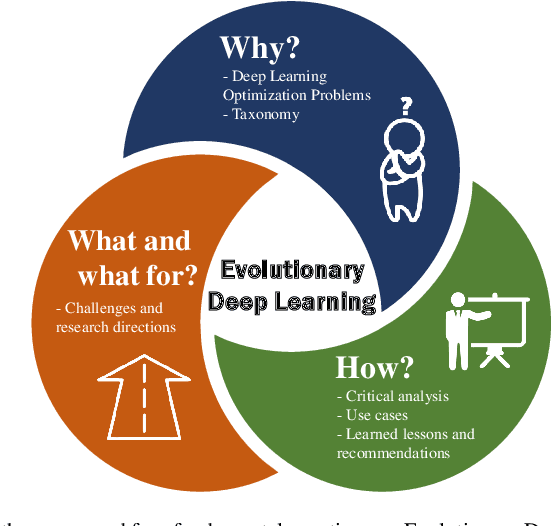
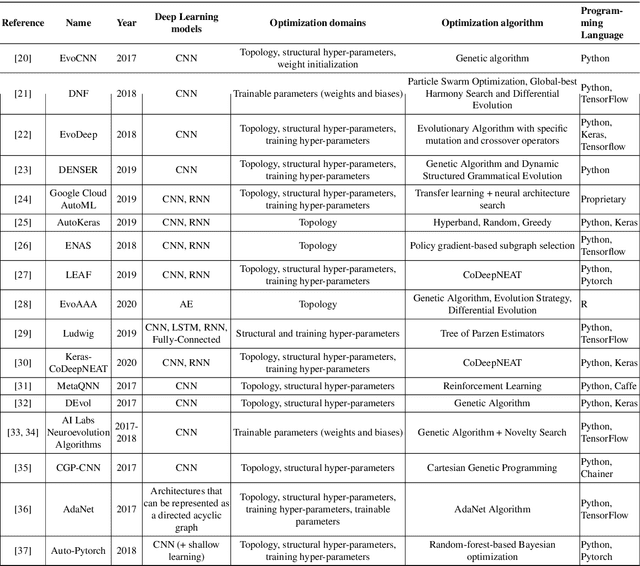

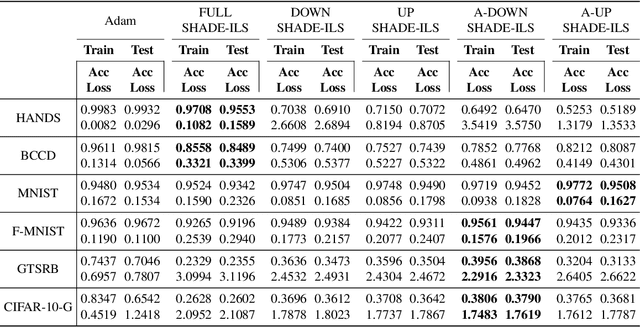
Abstract:Much has been said about the fusion of bio-inspired optimization algorithms and Deep Learning models for several purposes: from the discovery of network topologies and hyper-parametric configurations with improved performance for a given task, to the optimization of the model's parameters as a replacement for gradient-based solvers. Indeed, the literature is rich in proposals showcasing the application of assorted nature-inspired approaches for these tasks. In this work we comprehensively review and critically examine contributions made so far based on three axes, each addressing a fundamental question in this research avenue: a) optimization and taxonomy (Why?), including a historical perspective, definitions of optimization problems in Deep Learning, and a taxonomy associated with an in-depth analysis of the literature, b) critical methodological analysis (How?), which together with two case studies, allows us to address learned lessons and recommendations for good practices following the analysis of the literature, and c) challenges and new directions of research (What can be done, and what for?). In summary, three axes - optimization and taxonomy, critical analysis, and challenges - which outline a complete vision of a merger of two technologies drawing up an exciting future for this area of fusion research.
Comprehensive Taxonomies of Nature- and Bio-inspired Optimization: Inspiration versus Algorithmic Behavior, Critical Analysis and Recommendations
Feb 20, 2020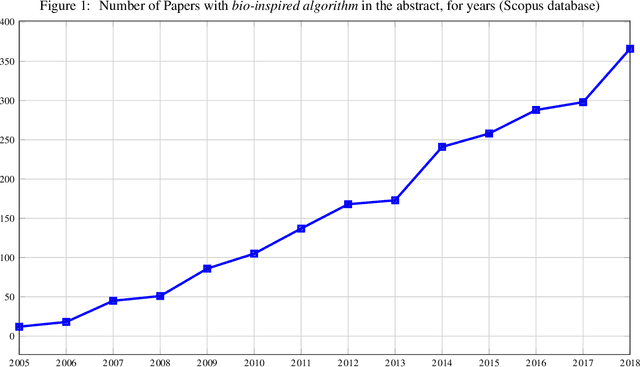
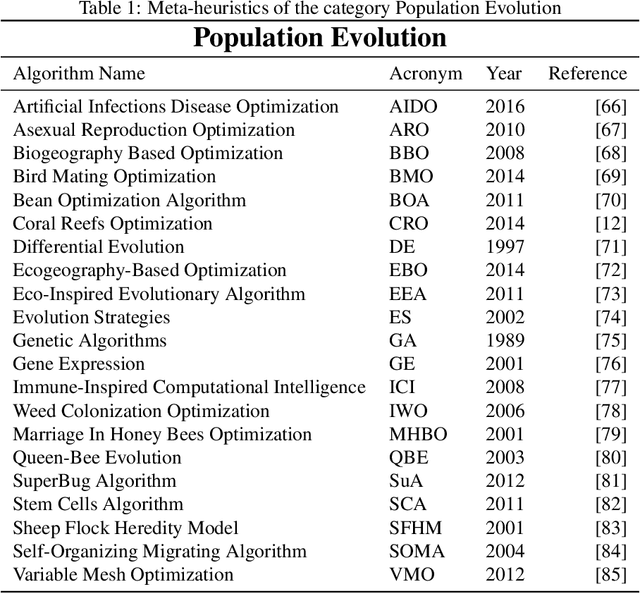
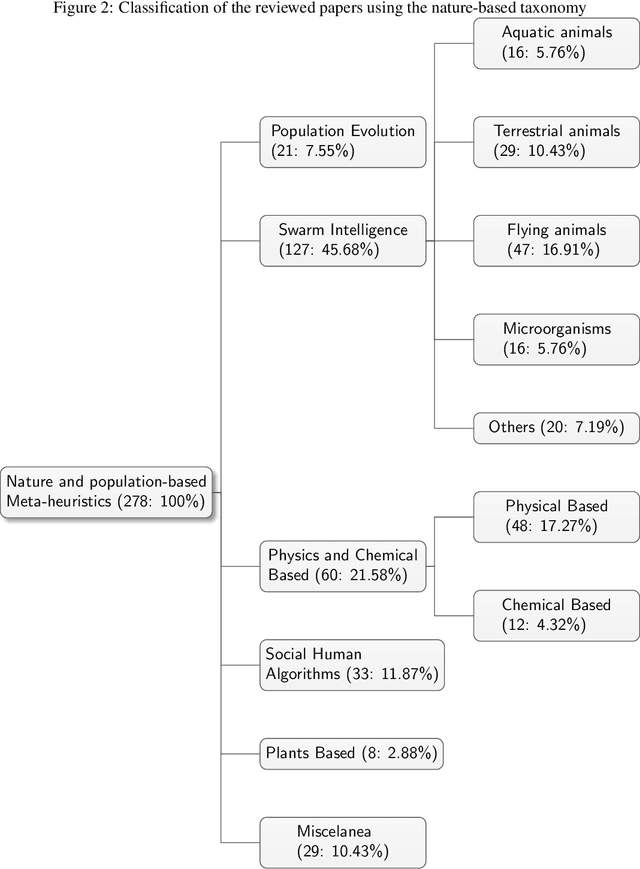
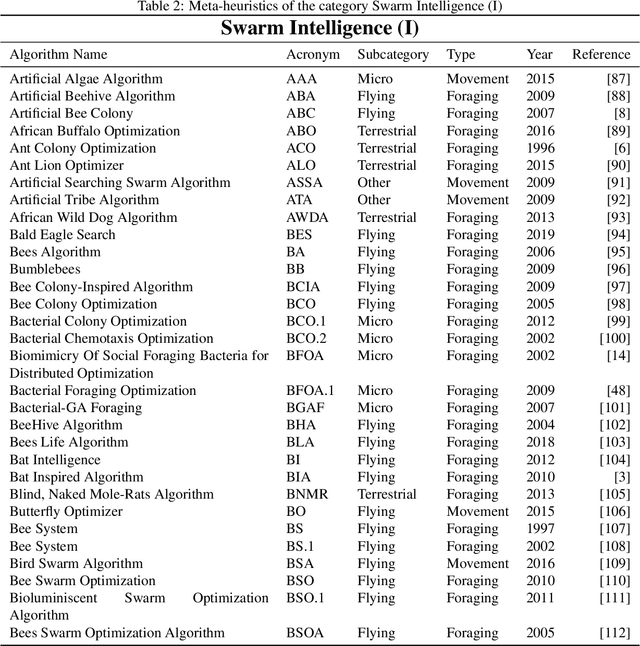
Abstract:In recent years, a great variety of nature- and bio-inspired algorithms has been reported in the literature. This algorithmic family simulates different biological processes observed in Nature in order to efficiently address complex optimization problems. In the last years the number of bio-inspired optimization approaches in literature has grown considerably, reaching unprecedented levels that dark the future prospects of this field of research. This paper addresses this problem by proposing two comprehensive, principle-based taxonomies that allow researchers to organize existing and future algorithmic developments into well-defined categories, considering two different criteria: the source of inspiration and the behavior of each algorithm. Using these taxonomies we review more than three hundred publications dealing with nature-inspired and bio-inspired algorithms, and proposals falling within each of these categories are examined, leading to a critical summary of design trends and similarities between them, and the identification of the most similar classical algorithm for each reviewed paper. From our analysis we conclude that a poor relationship is often found between the natural inspiration of an algorithm and its behavior. Furthermore, similarities in terms of behavior between different algorithms are greater than what is claimed in their public disclosure: specifically, we show that more than one-third of the reviewed bio-inspired solvers are versions of classical algorithms. Grounded on the conclusions of our critical analysis, we give several recommendations and points of improvement for better methodological practices in this active and growing research field.
 Add to Chrome
Add to Chrome Add to Firefox
Add to Firefox Add to Edge
Add to Edge